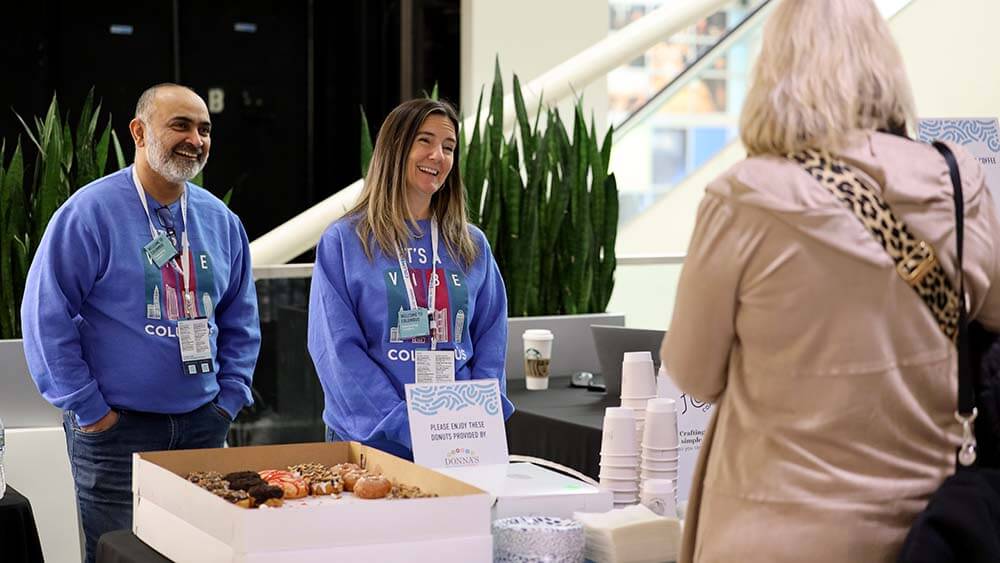
One way to design an event with empathy is to begin right away at registration — by providing snacks and drinks while attendees wait. (Whatever Media Group)

‘We sometimes forget that our audiences are made up of people.’ — Beth Surmont, CMP-Fellow, FASAE, CAE
Of all the tools in my event design toolbox, I think that empathy is the most powerful one. What sets good events apart from great events is the ability to anticipate the needs of the audience and deliver on them in simple, surprising, and delightful ways.
Think about everything we ask audiences to do when they come to our events. We are asking them to live someplace different, work someplace different, and be away from the people they know. We ask them to find their own ways to session rooms and around the expo hall. We often leave them to fend for themselves to find water or a piece of fresh fruit. We ask them to wade through dozens of sessions to determine which one they think is best for them and take a risk that it will be worth their time.
We sometimes forget that our audiences are made up of people. And people struggle when their base needs are not met. Remember Maslow’s Hierarchy: Before people can get to the place where they learn, grow, and have transformative experiences, they need to feel safe and comfortable and fed.
I’ve been an event planner for more than 20 years. I used to think that providing healthy options on the breaks and show floor maps was enough. I used to think that a detailed “Know Before You Go” email was all my audience needed to feel comfortable on site. I used to think that scheduling a reception enabled attendees to have the networking that they needed.
I was wrong.
My events were good, even highly rated. But they were missing the elements that made them great. And when I started to learn about design and how it starts with empathy for my audience, that’s when things reached a new level.
Empathy means seeing through another person’s eyes and fully understanding their experience. We can use this for events to make small and simple, yet significant changes that immediately add value to the experience. The best way to do this is through journey mapping.
Take the time to walk through your event, touchpoint by touchpoint, and look at every opportunity to remove friction. It is as simple as imagining someone moving through the event.
Let’s start at the beginning of their on-site experience and look at badge pick-up through the eyes of an attendee. They’ve spent the morning traveling — got up extra early to catch a flight, navigated the noise of the airport, and perhaps experienced some frustration with delays. They arrive at their hotel to learn their room is not ready and they are exhausted and hungry. They decide to get their badge. They may know the name of the room or area for badge pickup, but they must figure out how to navigate there. In some cases, for some attendees, this may even mean walking in places where they don’t feel fully comfortable.
They find the convention center, and after trying a few locked doors, one opens. Looking around they see a sign for their event in the distance. Tired, and still hungry, they walk over to find multiple lines and have a moment of confusion while they figure out which one to stand in. Fortunately, the line moves quickly, they type their name into the kiosk and a badge is printed with no issue. Feeling a small bit of relief after finally accomplishing at least one thing today, they pause. Now what?
They may already feel exhausted and the event hasn’t even started yet. Here are three ways we can improve their experience:
- Have a sponsored snack or lounge in the hotel for guests waiting for their rooms.
- Have greeters outside of doors of the convention center to direct people.
- Work with the CVB to have a custom walking map given out at the hotel, one that shows a pleasant route with local attractions and restaurants along the way.
Many of these would add only a nominal cost to the budget but would greatly improve this first touchpoint of the attendee experience. We leave a lot on the table when it comes to creating the optimal audience experience. Continuing this empathetic journey mapping through the rest of the design will help us create high-value, memorable events that will take our audiences to that next transformative level.
Beth Surmont, CMP-Fellow, FASAE, CAE, is vice president of event strategy and design for marketing, strategy, and experience agency 360 Live Media.
